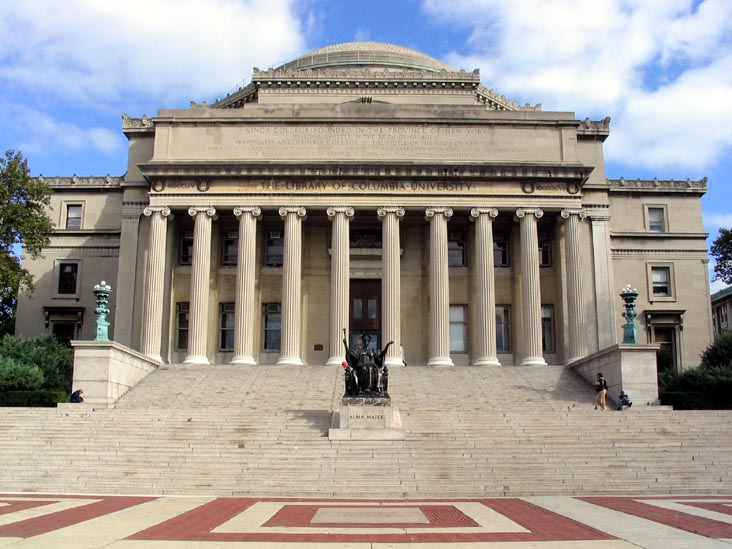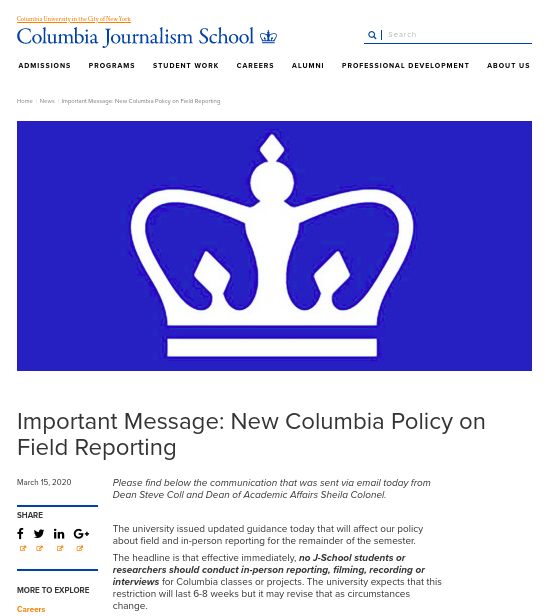As the coronavirus outbreak spread in March 2020, many journalism programs across North America did not establish clear policies for how students should conduct interviews.

One leader in setting policy, however, was Columbia University’s journalism program, which issued definitive instructions on field reporting, telling students and faculty to cancel all in-person interviews.
“Students, if you have plans or appointments for in-person reporting, please convert them to telephone or video interviews, or if this is not feasible, cancel or reschedule,” said the school’s deans in a notice on March 15.
Most universities closed their campuses, switched to online teaching and eventually banned most in-person meetings.
But a majority of journalism schools — 24 out of 32 — whose websites and email notices were reviewed by IJEC did not appear to publish any clear measures for students conducting interviews. IJEC also received several responses from professors that it queried.
At three of the 24 schools without policies, professors gave their own precautions to students. Other programs relied on campus-wide policies that followed the Centers for Disease Control (CDC) advice and discouraged in-person meetings.
“Limiting face-to-face contact with others is the best way to reduce the spread of coronavirus disease,” according to the CDC. “COVID-19 spreads mainly among people who are in close contact (within about 6 feet) for a prolonged period.”
The eight schools found to have published a policy for conducting interviews told students to not have any in-person contact with interviewees and to interview by phone or online. Those schools were, in addition to Columbia University:
- University of Wisconsin-Madison
- New York University
- City University of New York
- University of Maryland
- Indiana University
- University of Massachusetts
- University of Minnesota
Like most universities, the University of Wisconsin-Madison canceled all in-person instruction. Based on this guideline, instructors decided students should not be meeting anyone for interviews.
“I have told my 15 reporters in J420 Investigative Reporting that they are not to attend any meetings in person and that all interviews must be by phone, video chat or email,” wrote Dee Hall, who teaches at UW-Madison.
“A big part of the course includes one-on-one story editing and fact checking, which we will also do by video chat,” she added.
At Columbia’s graduate program, the instructors decided to change the topic of their reporting project.
“As soon as we realized that field reporting is not possible, we moved to a more relevant topic, which is COVID-19,” said assistant professor Denise Ajiri.

“Most of our work is data-driven and if we need to interview someone, we do it over the phone or via video calls,” she wrote. ” I am sure some students were disappointed, but they also understand the severity of the issue.”
Initially, some programs with broadcast classes suggested using shotgun microphones, which provide more than six feet of distance
“[N]ow I just grab my gear and never enter the newsroom again,” Ethan Stein, a student at Missouri, wrote in March. “I’m using zoom interviews and use user generated content.”
“But it’s certainly been different, he added. “Our managers have been great trying to keep us safe. One even tried taping a microphone on a six foot pole.”
Concern among journalists about contracting the virus heightened for many journalism programs and newsrooms in the U.S. and internationally after the last large journalism event of the year, the Investigative Reporters and Editors NICAR 2020 conference in New Orleans. IRE took extra precautions at the conference and encouraged conference-goers to be careful and use hand-sanitizers.
But one attendee of the conference tested positive for COVID-19 shortly after the conference ended on March 8. IRE alerted conference-goers on March 11 after it learned of the positive test.
Most of the 1,100 journalists, students and instructors who attended the conference immediately self-quarantined for 14 days or more. IRE reported on March 23 that one other conference-goer reported testing positive and that more than two dozen attendees had tested negative, but there has been no extensive survey of the conference attendees.